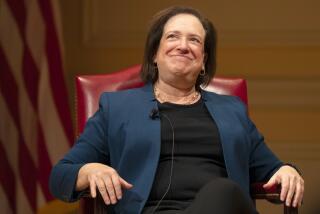Supreme Court to hear challenge to EPA powers on greenhouse gases
WASHINGTON — The Supreme Court agreed Tuesday to hear a utility industry challenge to the Obama administration’s ability to impose environmental regulations to limit greenhouse gases from stationary sources such as power plants, factories and refineries.
In a partial victory for industry, the justices agreed to decide whether the Environmental Protection Agency went too far when it extended its regulatory power over greenhouse gases beyond cars and trucks.
The U.S. Chamber of Commerce, one of six groups that challenged the “stationary source” regulation, said the EPA sought to impose “the costliest, farthest-reaching and most intrusive regulatory apparatus in the history of the American administrative state that could touch practically every aspect of every industry across the country.”
That claim no doubt got the attention of Chief Justice John G. Roberts Jr., who wrote in a dissent in a case in May of the “danger posed by the growing power of the administrative state.” He also said the court needed to take a closer look at agency regulations.
But the justices also have turned away even more aggressive challenges to the EPA’s authority to regulate heat-trapping greenhouse gas emissions. The Supreme Court ruled in 2007 that carbon dioxide and other greenhouse gases could be regulated as harmful pollutants under the Clean Air Act. Roberts and three fellow conservatives dissented from that decision.
In Tuesday’s order, the court signaled that it was not inclined to revisit the battle over whether the EPA can regulate greenhouse gases, but instead focus on how far the regulations may extend.
The Obama administration recently proposed rules to cut greenhouse gases from new power plants, and it is expected to propose limits for existing plants next June. Even if the court rules in industry’s favor, the EPA is expected to continue to develop the power plant rules under a different part of the statute.
“The power plant standards will go forward,” said Thomas Lorenzen, a former Justice Department official on environmental issues.
The high court’s mixed action was welcomed by industry as well as environmental advocates.
Business groups and several Republican-led states joined in challenging the EPA’s authority to regulate greenhouse gases beyond cars and trucks.
But Vickie Patton, general counsel for the Environmental Defense Fund, called the court’s decision to reject the broad challenge to the EPA a “historic victory” in the fight against global warming.
“Today’s orders by the U.S. Supreme Court make it abundantly clear, once and for all, that EPA has both legal authority and the responsibility to address climate change and the carbon pollution that causes it,” she said.
The question the court will focus on centers on a provision of the Clean Air Act that requires stationary sources of air pollution to seek permits and provide plans to reduce emissions if they are significantly expanding an existing facility or building a new one.
So far, the provision has applied to pollutants other than greenhouse gases. Expanding the provision to include greenhouse gases could create the need for millions of facilities to acquire permits, whether power plants or farms or landfills. To avoid such a scenario, the EPA issued a rule in 2010 that would limit the need for permits to only large emitters. The court has taken up industry’s challenge against the EPA’s focus on the biggest polluters.
During its first term, the Obama administration adopted rules to cut greenhouse gases from cars and light trucks. That set the stage for the pending power plant rules. A ruling by the court against the EPA in this case would be likely to blunt only one of the tools available to the agency to address climate change, environmental experts said.
“If the central question is, ‘Can the EPA keep moving forward to get [the] power plants’ rule out the door?’ the answer is ‘Yes,’” said Jody Freeman, a law professor at Harvard University and the White House energy and climate change advisor during Obama’s first term.
But much depends on how the court eventually rules, said Jacob Hollinger, who until recently served as a lawyer for the EPA in the New York-New Jersey area.
“It could be a very narrow opinion and just about permitting requirements,” Hollinger said. “Or one could imagine a much more broad opinion, one that would say that what’s appropriate for motor vehicles are not appropriate for other sections of industry and the economy.”
The narrowness of the question the court is examining seems to bode well for the EPA and environmentalists, Hollinger said.
“In the end, industry has lost no matter what because what they wanted reviewed was much more dramatic,” Freeman said. “All told, I’d imagine the EPA is feeling a little bit relieved.”
The lead appeal was Utility Air Regulatory Group vs. EPA. The justices will hear arguments during the winter and hand down a decision by June.
More to Read
Sign up for Essential California
The most important California stories and recommendations in your inbox every morning.
You may occasionally receive promotional content from the Los Angeles Times.











